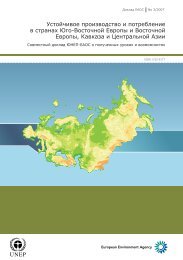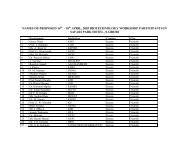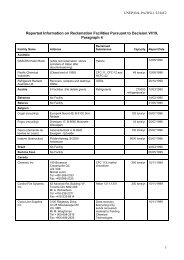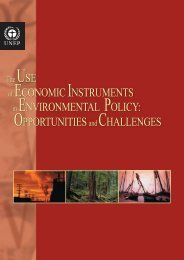Energy Subsidies: Lessons Learned in Assessing their Impact - UNEP
Energy Subsidies: Lessons Learned in Assessing their Impact - UNEP
Energy Subsidies: Lessons Learned in Assessing their Impact - UNEP
Create successful ePaper yourself
Turn your PDF publications into a flip-book with our unique Google optimized e-Paper software.
<strong>Energy</strong> <strong>Subsidies</strong>: <strong>Lessons</strong> <strong>Learned</strong> <strong>in</strong> Assess<strong>in</strong>g <strong>their</strong> <strong>Impact</strong> and Design<strong>in</strong>g Policy Reforms<br />
quantity consumed plus any direct f<strong>in</strong>ancial payment to consumers that reduced the price paid<br />
for domestic consumption.<br />
The price-gap approach <strong>in</strong>volves compar<strong>in</strong>g actual end-user prices of energy products with<br />
reference prices, def<strong>in</strong>ed as those prices that would prevail <strong>in</strong> undistorted markets <strong>in</strong> the<br />
absence of subsidies. The difference between the two is the “price gap”. 8 Comb<strong>in</strong><strong>in</strong>g the<br />
percentage change <strong>in</strong> prices (the price gap divided by the reference price) with the elasticity<br />
of demand yields the change <strong>in</strong> consumption that would result from the complete elim<strong>in</strong>ation<br />
of subsidies that cause the price gap. This approach has the attraction of conceptual and<br />
analytical simplicity. But it also has limitations. It only captures the effects of subsidies on<br />
economic efficiency to the extent that they lower or <strong>in</strong>crease the end-use price of the good.<br />
Moreover, the price-gap measures only the net price effect of all the different subsidies; a mix<br />
of subsidies may result <strong>in</strong> a zero net price-gap but still <strong>in</strong>volve significant efficiency losses.<br />
Because it relies on simple assumptions, it cannot take <strong>in</strong>to account the effects that, for<br />
example, ration<strong>in</strong>g may be hav<strong>in</strong>g on the consumption of energy at the current price. This<br />
approach is, therefore, ma<strong>in</strong>ly suitable for produc<strong>in</strong>g a broad estimate of the impact of<br />
subsidies on consumption levels and, therefore, the potential reduction <strong>in</strong> greenhouse-gas<br />
emissions from subsidy removal.<br />
2.3 The Size of <strong>Energy</strong> <strong>Subsidies</strong><br />
<strong>Energy</strong> subsidies are widespread, but they vary greatly <strong>in</strong> importance and type accord<strong>in</strong>g to<br />
the fuel and country. Estimat<strong>in</strong>g <strong>their</strong> size depends heavily on def<strong>in</strong>itions and methodologies.<br />
Big differences <strong>in</strong> def<strong>in</strong>itions make comparisons of <strong>in</strong>dividual studies of the impact of energy<br />
subsidies <strong>in</strong> specific countries or regions difficult and complicate discussions of issues<br />
relat<strong>in</strong>g to subsidies and <strong>their</strong> reform.<br />
Very few studies have attempted to quantify energy subsidies for the world as a whole,<br />
because of data deficiencies and the sheer scale of the exercise. The most well known global<br />
study, carried out by Larsen and Shah <strong>in</strong> 1992, put world fossil-fuel consumption subsidies<br />
from under-pric<strong>in</strong>g alone at around $230 billion per year. The Former Soviet Union accounted<br />
for around two-thirds of that and develop<strong>in</strong>g countries for most of the rest. An OECD study,<br />
published the same year, estimated net global consumption subsidies at $235 billion per year,<br />
with $254 billion of net subsidies <strong>in</strong> non-OECD countries offsett<strong>in</strong>g $19 billion <strong>in</strong> net energy<br />
taxes <strong>in</strong> the OECD. A more recent multi-country study analysis by Myers and Kent estimated<br />
fossil fuel subsidies world wide at $133 billion. 9 Other recent studies confirm that energy<br />
consumption subsidies are much bigger <strong>in</strong> non-OECD countries. A 1997 World Bank study<br />
estimated annual fossil-fuel subsidies at $48 billion <strong>in</strong> twenty of the largest countries outside<br />
the OECD and $10 billion <strong>in</strong> the OECD, although the scope of the subsidies considered was<br />
narrow. A related OECD study looks at end<strong>in</strong>g coal-production subsidies as part of a broader<br />
assessment of the environmental effects of liberalis<strong>in</strong>g trade <strong>in</strong> fossil fuels. This study is<br />
discussed <strong>in</strong> further detail <strong>in</strong> the annex.<br />
The overall size of energy subsidies has fallen sharply s<strong>in</strong>ce the 1980s, ma<strong>in</strong>ly due to<br />
economic reform and structural adjustment programmes <strong>in</strong> the former communist bloc and<br />
other non-OECD develop<strong>in</strong>g countries. <strong>Subsidies</strong> dropped by over half <strong>in</strong> the five years to<br />
8 See Annex, Section A1, for examples of studies that have used this approach.<br />
9 See Myers and Kent (2001).<br />
24
















